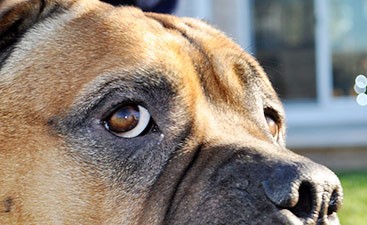Overview
The eye is a complicated thing. In order to absorb light and receive an adequate blood supply, the eye needs help from the choroid, a collection of blood vessels within a layer of tissue located under the retina.
When this part of the eye doesn’t develop the right way in dogs, it can lead to Collie Eye Anomaly (CEA) – a genetic disease that affects Collies as well as other dog breeds. Also known as Choroidal Hypoplasia, this condition can lead to vision loss.
CEA is a genetic condition that’s usually found in Collies and other herding dogs. Breeds affected include:
- Rough Collies
- Smooth Collies
- Border Collies
- Australian Shepherds
- Shetland Sheepdogs

Signs and Symptoms
The signs and symptoms of CEA vary from dog to dog. For some dogs, it’s not so bad, while for others, it can lead to vision loss due to holes or pits in different layers of the eye. Depending on the size and location of the holes, vision loss can be slight or total. CEA can also lead to retinal detachment.
Unfortunately, there might not be any warning until a dog starts showing symptoms of blindness. Fortunately, a thinning, poorly developed choroid can be detected early, in puppies as young as 5-8 weeks. Therefore, it’s important to have puppies examined early.

Diagnosis and Treatment
In puppies, the most common sign of CEA – a thinning choroid – isn’t visible to the naked eye, so it’s important to have a puppy’s eyes thoroughly inspected early. It’s not always easy to catch, either. As puppies grow up, there are some normal changes that occur in the retina that may hide the presence of thin spots in the choroid.
If your dog shows signs of blindness, your veterinarian will perform a complete history and physical exam, including a thorough eye exam. Your vet may also refer you to a veterinary ophthalmologist for additional evaluation and may want to run more tests to rule out other causes of blindness. These tests may include:
- Chemistry tests to evaluate kidney, liver, and pancreatic function, as well as sugar levels
- A complete blood count to screen blood-related conditions
- Electrolyte tests to ensure your pet isn’t suffering from an electrolyte imbalance
- Blood pressure measurement
- Screening tests to rule out infectious disease
- X-rays of the chest and abdomen to look for abnormalities
Unfortunately, there’s no real cure for CEA. For dogs that experience setbacks from CEA, such as retinal detachment or holes in layers of the eye (coloboma), surgery may help to minimize the negative effects.
There is good news, though – for many dogs, the condition doesn’t worsen enough to cause vision loss at all.
Prevention
Because it’s a genetic condition, there’s no prevention for CEA. The best way to eliminate it is to avoid breeding dogs with the gene or evidence of CEA on ocular examination. In addition, there are tests that can be run to let you know if your dog carries the CEA gene.
If you have any questions or concerns, you should always visit or call your veterinarian – they are your best resource to ensure the health and well-being of your pets.
